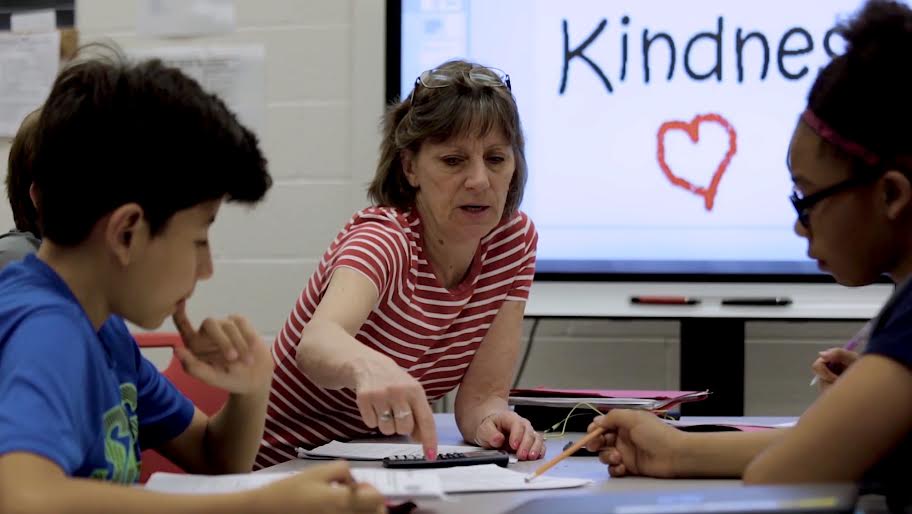Thanks to the persistence of social entrepreneurs across the country, every day we see strategies that are working and delivering results in a rapidly changing world. This Evidence in Action blog series highlights the voices of the more than 70 social innovation organizations that make up the America Forward Coalition, the results-driven solutions our community has to our country’s most pressing social problems, and the evidence-based federal programs that are critical to scaling the impact of this work. Today, we hear from America Forward Coalition organization New Classrooms Innovation Partners (New Classrooms) about the impact of their Teach to One: Math program, with help from an Investing in Innovation (i3) grant from the Department of Education.[1]

For Kathy Healy, the joy of teaching comes from seeing the process of learning unfold in the classroom:
“I enjoy watching students learn,” says Healy, a math teacher at Nathan Hale Middle School in Connecticut. “The AHA! moment, when they finally get it. That’s my passion.”
Healy is part of the instructional team at Nathan Hale that is reimagining how students learn math through personalized learning. Last year, the school launched Teach to One: Math (Teach to One) for sixth grade students in response to a structural problem that persists in schools across the country: Every year, teachers are asked to teach grade-level curriculum to dozens of students who come in with different levels of preparation and a range of learning needs.
At Nathan Hale, students made significant gains the first year, outpacing peers around the country by 1.3 times the national average on NWEA’s MAP Growth assessment. In other words, Nathan Hale students learned an extra three to four months of material over the course of the school year. This year, the school is expanding Teach to One: Math to serve students in all grades.
These student gains mirror district-wide achievements across Norwalk Public Schools, which has made personalized learning initiatives central to long-term strategic plans. It’s also consistent with promising impact data that Teach to One partner schools are seeing across the country. That includes a third-party evaluation conducted by Teachers College, Columbia University, which found that students made annual academic gains that were equivalent to a half year of additional learning compared to national averages. The evaluation found that English language learners and special education students accelerated their learning at an even greater pace.
A Partnership for Success
Meeting students where they are has long been a priority for Nathan Hale, which is why the school was a good fit to implement a holistic personalized learning model like Teach to One. The program provides teachers with a curated bank of high-quality learning resources that match students’ skill levels and address knowledge gaps. Each day, it assigns individual students to at least one of nine instructional approaches, called “learning modalities.” Students end by taking an online exit ticket to assess their grasp of that day’s concept. Data from that exit slip is then analyzed to generate a customized lesson plan for the next day.
“We have different modalities, so the kids have the opportunity to learn a skill in different ways,” says Healy. “They could have a live lesson with a teacher, they could be learning with a peer, or they could be learning with a small group.”
Principal Albert Sackey said that the shift toward personalized learning has led to unexpected benefits. The teachers appreciate the variety of each day and the opportunity to work more collaboratively with each other. Dr. Sackey said it also supports the school in ways that are not always visible.
“It does a lot of behind-the-scenes thinking that we don’t really have to focus on so that we can focus on teaching and learning,” Dr. Sackey said.
Meeting Students Where They Are at Scale
Reimagining a learning model that meets students where they are will take more than new textbooks, computers, or software apps. What is needed are personalized learning models that are structurally oriented around meeting the unique needs of each student, each day.
It takes pioneering teachers, principals, and district leaders to embrace this shift. New Classrooms has spent the last five years working with these innovative educators to implement and refine Teach to One so that it is viable in all different kinds of schools. Teach to One’s powerful scheduling engine now generates thousands of personalized schedules every day, and it’s getting more efficient and sophisticated each year.
Much of this work would not have been possible were it not for national initiatives that share a vision for the future of personalized learning. In 2014, New Classrooms secured a federal grant through the Investing in Innovation Fund (i3) to support the expansion and evaluation of Teach to One: Math. This grant, and other funding opportunities like it, have put New Classrooms in a position to “crack the operational code” to build a scalable program that can benefit students across the country.
New Classrooms is now focused on using our technological capabilities to “crack the academic code” and share evidence-based insights on how students learn best. What are the optimal learning progressions for students to understand the Pythagorean theorem? What lessons have the greatest impact on mastery of fraction operations? What are the implications of exposing students to skills and concepts if they aren’t fully proficient in predecessor skills and concepts? These are the sorts of questions that New Classrooms will be asking and answering in the coming years, not only to improve our model, but also to share lessons learned with the broader K-12 community.
This post is part of America Forward’s Evidence in Action blog series. Follow along on Twitter with #EvidenceinAction and catch up on the series here.
[1] The Education Innovation and Research (EIR) Program, established under section 4611 of the Elementary and Secondary Education Act (ESEA), as amended by Every Student Succeeds Act (ESSA) replaced the Investing in Innovation Fund (i3) in 2015.
Leave a Reply
You must be logged in to post a comment.